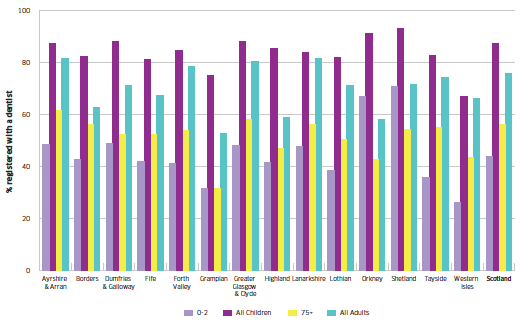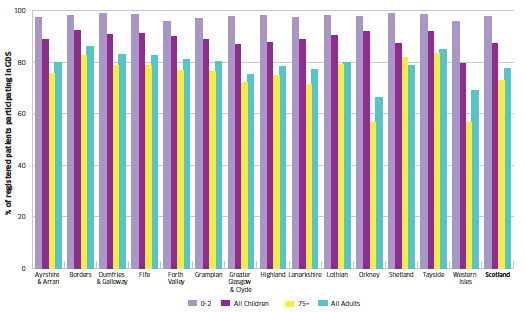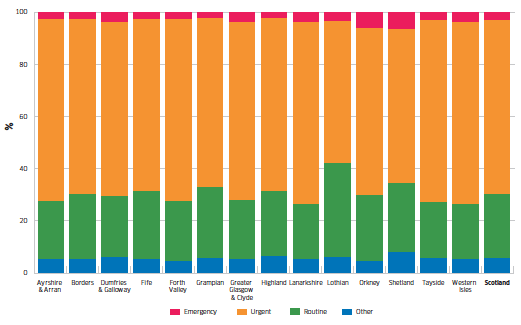Annual Report Of The Chief Dental Officer 2012
Inaugural Annual Report on the dental health of the Scottish population from the Chief Dental Officer, Margie Taylor.
5. Utilisation of Dental Services
5.1 Primary Care Dental Services
Primary care dentistry is usually the first point of contact for patients seeking dental treatment. The majority of dental treatment is provided by independent general dental practitioners (GDPs) working on behalf of local NHS boards; salaried general dental practitioners provide an alternative service to independent GDPs to help meet the oral health needs of the local population.
At 31st March 2012, there were 3,115 GDPs - independent and salaried - contracted to provide NHS dental services in Scotland within the NHS general dental services framework. The Statement of Dental Remuneration, set by the Scottish Government, determines the fees associated with each item of treatment for general dental practitioners and payments for adults and children registered; dentists may also receive centrally-funded allowances and grants.
Patients registered with an NHS dentist can receive the full range of NHS treatment ranging from simple examinations to complex restorative and advanced surgical treatments. Adult patients, unless exempt from charges, contribute 80% of the total fee, up to a maximum of £384 (www.psd.scot.nhs.uk/dentists/treatment-costs.html). The fees for child patients (those under 18 years) are paid by local NHS boards.
The Dental Workforce Report 2012 (http://nes.scot.nhs.uk/education-and-training/by-discipline/dentistry/about-dentistry/resources/publications/dental-workforce-report-september-2012.aspx) highlights the fact that, as in similar areas of health and care, the utilisation of dental services is a function of the supply of dental services and the demand for dental services. Although information is captured about people registered with an NHS dentist, there is no centrally-held information about people seeking and using private dental care. Data from the 2009 Scottish Health Survey suggested that, in a 12-month period, 17% had received private dentistry (www.scotland.gov.uk/Publications/2010/09/23154223/24).
5.1.1 Registration
In April 2010, non-time-limited registration for patients was introduced. This "life-long" registration is designed to allow children and adults to stay registered with a dentist for life. The continuous, practioner-patient relationship this change introduces is consistent with arrangements elsewhere in primary care, such as general medical services; it aims to promote a more stable relationship between dentist and patient to improve attendance and enable long-term monitoring and management of oral health.
Registration rates for both children and adults have increased over the past two years, with more than 87% of children and 75% of adults registered at the end of March 2012 (https://isdscotland.scot.nhs.uk/Health-Topics/Dental-Care/Publications/2013-05-28/2013-05-28-Dental-Report.pdf?35259646178). Figure 5.1 illustrates registration rates by key age groups in NHS board areas and shows that the national registration rate in the 0-2-year-age group is below the target of 55% of 0-2-year-olds to be registered with a dentist. The level of adults registered aged 75 and older is also low, at just over 50%.
Figure 5.1 Percentage of population registered with an NHS dentist by NHS board; March 2012

Source: http://isdscotland.org/Health-Topics/Dental-Care/Publications/data-tables.asp?id=705#705
5.1.2 Participation
Registration itself does not tell the whole story; it is one of a number of markers that indicate accessibility of general dental services to the population. Participation, as used by the NHS Information Services Division, is a measure of patient attendance at an NHS general dental practice for registration or treatment or other form of contact within the last 2 years. Participation rates are therefore a further indicator of the care that patients are accessing. Figure 5.2 demonstrates the participation rates per NHS board area, with the highest participation rates for children seen in Borders and the lowest in the Western Isles, while rates for adults were highest in Borders and lowest in Orkney.
Figure 5.2 Percentage of registered NHS patients participating in general dental services over a 2-year period; March 2012

Source: http://www.isdscotland.org/Health-Topics/Dental-Care/Publications/data-tables.asp?id=705#705
5.1.3 Treatment
During 2011/12 there were over 4 million courses of treatment provided in primary dental care by both independent dental contractors and salaried general dental services, an increase of 7% from the year before. Approximately 88% of the courses of treatment carried out were for adults and 12% for children.
Key points:
- In 2011/12, GDS dentists carried out nearly 2.7 million examinations, an increase of 5.5% from 2010/11.
- The number of teeth extracted by GDS dentists amounted to nearly 545,000 in 2011/12, an increase of 2.5% from the year before.
- During 2011/12, there were increases in the number of radiographs taken, simple and complex periodontal treatments, fillings, root treatments, crowns, dentures, domiciliary visits, surgical treatments, sedations and orthodontic treatments.
- Decreases were observed in 2011/12 over the previous year in treatments involving veneers, inlays and bridges.
5.1.4 Access
In 1997, the Scottish Dental Access Initiative (SDAI) was introduced to improve access to NHS general dental services in parts of Scotland where, historically, availability of GDS had been variable. There has been significant investment over the past few years in expanding dental services in areas where there were still insufficient primary care dental services to meet demand, particularly rural areas, and where people were not registered with a dentist. There were also problems in areas where some dentists developed the private side of their businesses, with the result that the limited numbers of NHS patients registered with them did not justify the establishment of full-time practices.
Despite the opening of new premises, there remains a perception that it is still difficult to find an NHS dentist, but access is at its highest ever level. All NHS boards have dedicated dental advice phone lines to help those not registered with a dentist to find a dentist in their vicinity. Action in future will be focused more on how best to promote the services that are available and on those practices that are willing to take NHS patients.
Dental outreach centres have been established by salaried dental services, further increasing access to dental services, while at the same time benefiting the dental undergraduate student experience.
5.1.5 Allowances
Allowances and Rates and Rent Reimbursement payments have encouraged practitioners to remain committed to NHS dentistry and contributed significantly to their and their practices' incomes.
The Scottish Emergency Dental Services (SEDS) operates across all areas of Scotland (except Edinburgh City, and East and Midlothian, where other arrangements are in place). SEDS is a coordinated, multi-centred service that accommodates unregistered patients.
Via NHS24 (www.nhs24.com), SEDS provides a single-point telephone access, triaged by dental nurses using a clinical decision support system and centralised patient booking arrangements. Individual NHS boards are responsible for the local services that enable treatment to be provided within national target times.
Patients are assessed and assigned to one of three categories according to the urgency of the condition:
- Emergency (requiring contact with a clinician within 1 hour).
- Urgent (requiring treatment within 24 hours).
- Routine care (where self-help measures are considered adequate and patients given appropriate advice).
In the year to September 2012, NHS 24 received 74,614 dental calls. There are fluctuations in the number of calls received each month, but effective service planning ensures staffing levels meet demand. The busiest months are December/January and April/May due to the concentration of public holidays. Figure 5.3 shows this information split by triage category (as defined by SDCEP guidance) for the year in question (emergency, urgent, routine and other).
Figure 5.3 NHS 24 triaged calls by NHS board; 12 months to September 2012

Source: NHS 24 data
5.3 Community Dental Services
The community dental service (CDS) is a directly managed service, providing services which are complementary to the GDS and specialist services. It offers care to priority groups, including those with special needs, and acts as a safety net for those who cannot access general dental services. The CDS provides an essential public health role, which includes epidemiology and oral health improvement.
5.4 Hospital Dental Services
Hospital dental services (HDS) in Scotland are accessed via referral from primary care dentists and doctors. Procedures carried out are generally confined to more complex dentistry which is beyond the scope of primary care.
5.5 Utilisation of Services
Data on GDS dental activity are readily available, and plans are in place to better record the activities of the community dental services (CDS). Recommendations from the Dental Workforce Report 2010 (www.scotland.gov.uk/Publications/2011/03/07154848/19) include the need to better record hospital dental data. An implementation group has been tasked with enhancing such dental data quality with a view to aiding planners and decision makers in the future; with the increases in the number of dental care professionals providing NHS services, there is a need to capture more robust information on the care they are delivering.
Contact
Email: Elizabeth McLear
There is a problem
Thanks for your feedback